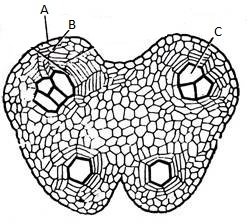In a cereal grain, the single cotyledon of the embryo is represented by:
1.
coleorhiza
2.
scutellum
3.
prophyll
4.
coleoptiles
Rarely among angiosperms, the pollen grains influenced the endosperm. This is called as:
1. Meta xenia
2. nemec phenomenon
3. Xenia
4. Mesogamy
The following is the diagram of TS of Anther. Identify the parts labelled as A, B and C.

1. A-Epidermis, B-Endothecium, C-Spongenous
2. A-Endothecium, B-Connective, C-Pollengrain
3. A-Pollen grain, B-Connective, C- Endothecium
4. None of the above

In the given diagram, parts labeled as A, B, C, D, E and F are respectively identified as:
1. synergids, polar nuclei, central cell, antipodals, filiform apparatus and egg
2. polar nuclei, egg, antipodals, central cell, filiform apparatus and synergids
3. egg, synergids, central cell, filiform apparatus, antipodals and polar nuclei
4. central cell, polar nuclei, filiform apparatus, antipodals, synergids and egg
In some organisms, karyokinesis is not followed by cytokinesis as a result of which, the multinucleate condition arises leading to the formation of the syncytium. The perfect example for this is:
1. Appearance of a furrow in cell membrane
2. Liquid endosperm in coconut
3. Sexual reproduction
4. Fertilization
Double fertilization occurs in:
1. Riccia
2. Pteridium
3. Cycas
4. Capsella
| I. | Tapetum nourishes the developing pollen grains. |
| II. | Hilum represents the junction between the ovule and the funicle. |
| III. | In aquatic plants such as water hyacinths and water lily, pollination is by water. |
| IV. | The primary endosperm nucleus is triploid. |
1. I, II, and IV are correct, but Ill is incorrect
2. I and II are correct, but Ill and IV are incorrect
3. I and IV are correct, but II and Ill are incorrect
4. I, Ill and IV are correct, but I is incorrect
1. Gramineae
2. Solanaceae
3. Orchidaceae
4. Malvaceae
Persistent nucellus in the seed is known as:
| 1. | Tegmen | 2. | Chalaza |
| 3. | Perisperm | 4. | Hilum |
In some plants, the female gamete develops into an embryo without fertilization. This phenomenon is known as:
| 1. | Parthenogenesis | 2. | Autogamy |
| 3. | Parthenocarpy | 4. | Syngamy |






